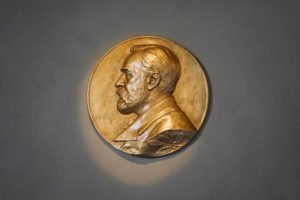
Jan Tinbergen
1903-1994
In 1969 Dutch economist Jan Tinbergen and Norwegian economist Ragnar Frisch shared the first Nobel Prize in economics “for having developed and applied dynamic models for the analysis of economic processes.” Tinbergen, who held a Ph.D. in physics, had become interested in economics while working on his dissertation, “Minimum Problems in Physics and Economics” (1929). He began to apply mathematical tools to economics, which at the time was a relatively verbal and nonmathematical discipline. In 1929 he joined a unit of the Dutch Central Bureau of Statistics to do research on business cycles. He stayed there until 1945, taking a leave of absence from 1936 to 1938 to work for the League of Nations in Geneva.
Along with Frisch and others Tinbergen developed the field of econometrics, the use of statistical tools to test economic hypotheses. Tinbergen was one of the first economists to create multiequation models of economies. He produced a twenty-seven-equation econometric model of the Dutch economy, and his 1939 book, Business Cycles in the United States, 1919–1932, includes a forty-eight-equation model of the American economy that explains investment activity and models American business cycles.
Another of Tinbergen’s major contributions was to show that a government with several economic targets—for both the unemployment rate and the inflation rate, for example—must have at least as many policy instruments, such as taxes and monetary policy.
About the Author
David R. Henderson is the editor of The Concise Encyclopedia of Economics. He is also an emeritus professor of economics with the Naval Postgraduate School and a research fellow with the Hoover Institution at Stanford University. He earned his Ph.D. in economics at UCLA.
Selected Works
Related Entries

